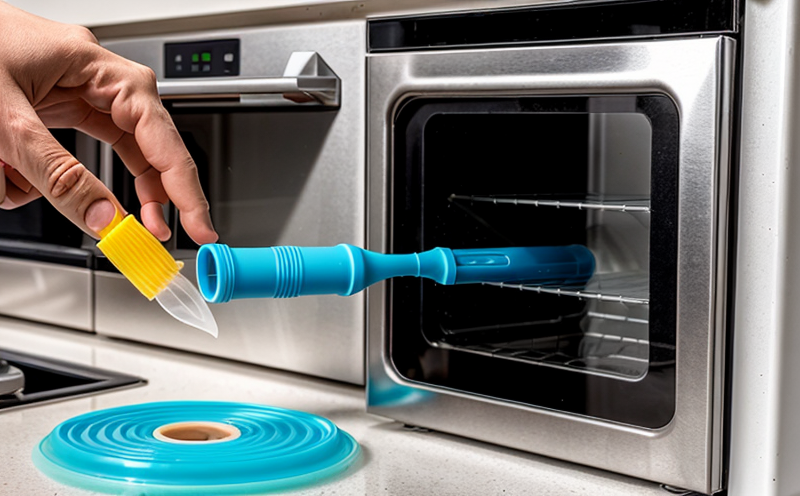ASTM E831 Coefficient of Thermal Expansion Testing of Household Plastics
The ASTM E831 standard test method is designed to determine the coefficient of thermal expansion (CTE) for solid materials, including household plastics. This property is crucial for ensuring that plastic components in products like kitchenware, toys, and furniture do not degrade or expand excessively under varying temperatures, which can impact product performance and safety.
The CTE test measures how much a material expands when heated and contracts when cooled. For household plastics, this measurement is essential as it directly affects the durability and functionality of products in everyday use. Household plastics often come into contact with various environmental conditions that include temperature fluctuations, which can lead to stress if not properly accounted for.
The ASTM E831 test procedure involves subjecting a specimen to controlled heating and cooling cycles while measuring its dimensional change using precise instruments like thermomechanical analyzers (TMA). This testing ensures compliance with international standards such as ISO 75, which specifies the basic principles of thermal expansion measurements. Compliance is critical for manufacturers who aim to produce high-quality products that meet safety and performance expectations.
Specimen preparation involves cutting samples from the plastic product according to ASTM E831 specifications. The specimens should be representative of the material properties being tested, ensuring accurate results. During testing, temperature changes are controlled within a specified range, typically between room temperature and 200°C, depending on the specific plastic type.
Instrumentation used for this test includes high-precision thermomechanical analyzers that can accurately measure minute dimensional changes in the specimen as it is subjected to thermal cycles. The results are reported in units of micrometers per meter per degree Celsius (μm/m/°C), providing a quantifiable measure of the material's response to temperature variations.
The ASTM E831 method allows for both uniaxial and biaxial testing, depending on the product design. Uniaxial tests are typically used for simpler products like plastic containers or pipes, while biaxial tests are more appropriate for complex geometries found in household appliances.
Understanding the CTE of household plastics is vital for quality assurance and compliance with regulatory standards such as FDA regulations for food-contact surfaces. This test ensures that the materials used do not leach harmful substances into food or beverages, maintaining product safety. Additionally, it helps in optimizing design parameters to enhance the performance and longevity of products.
In summary, ASTM E831 testing is a critical process for manufacturers of household plastics who need to ensure their products meet rigorous quality standards. By accurately measuring CTE, this test contributes significantly to product reliability, safety, and compliance with international regulations.
Eurolab Advantages
At Eurolab, we offer comprehensive polymer and plastics testing services tailored specifically for household products. Our state-of-the-art facilities equipped with advanced TMA equipment ensure precise measurements, providing reliable data that meet the highest industry standards.
We employ highly skilled technicians who are experts in ASTM E831 methodology, ensuring accurate specimen preparation and consistent test results. With our wide range of testing capabilities, we can provide detailed reports that go beyond basic compliance to offer valuable insights into material performance under various conditions.
Our commitment to quality is reflected not only in our testing processes but also through continuous training for our staff and investment in cutting-edge technology. This ensures that we stay at the forefront of industry practices, offering clients the most up-to-date information and support they need.
We understand the importance of timely delivery and confidentiality when it comes to sensitive product development projects. Our efficient project management systems guarantee prompt turnaround times without compromising on accuracy or detail. Moreover, our secure data handling policies ensure that all client information remains confidential throughout every stage of testing.
Why Choose This Test
The ASTM E831 Coefficient of Thermal Expansion Testing of Household Plastics is essential for ensuring the safety, durability, and performance of products in everyday use. By accurately measuring how household plastics respond to temperature changes, this test helps identify potential issues early on during product development, allowing manufacturers to make necessary adjustments before production.
For quality managers, ASTM E831 provides a critical tool for maintaining consistent quality across all manufactured items. It allows them to monitor changes in material properties over time and ensure that new batches of plastic meet the same high standards as previous ones. Compliance officers can rely on these test results to demonstrate adherence to regulatory requirements, reducing the risk of non-compliance penalties.
For R&D engineers, this test offers invaluable data for optimizing product designs. Understanding how different types of household plastics behave under varying temperatures enables them to create more efficient and reliable products that better withstand real-world conditions. This information is particularly useful when developing new materials or improving existing ones.
In the procurement process, knowing the CTE values helps ensure that suppliers provide materials that will perform as expected in various environments. By specifying these requirements early in negotiations, buyers can avoid costly rejections later on due to unsuitable materials.
Environmental and Sustainability Contributions
The ASTM E831 test plays a significant role in promoting environmental sustainability by ensuring that household plastics are designed and manufactured with consideration for their entire lifecycle, from production through use to disposal. By understanding how these materials behave under temperature variations, manufacturers can select more environmentally friendly options that minimize waste generation.
For instance, if a plastic component is known to expand significantly at high temperatures, designers might opt for alternative materials that exhibit better dimensional stability. Such decisions contribute positively towards reducing landfill contributions and promoting recycling practices. Additionally, knowing the CTE helps in selecting appropriate additives or reinforcements that improve both performance and recyclability.
Furthermore, compliance with ASTM E831 ensures that household products meet stringent safety standards, which indirectly supports environmental health by preventing contamination from hazardous substances leaking into soil or water sources during disposal. This aligns closely with broader sustainability goals aimed at protecting ecosystems for future generations.





